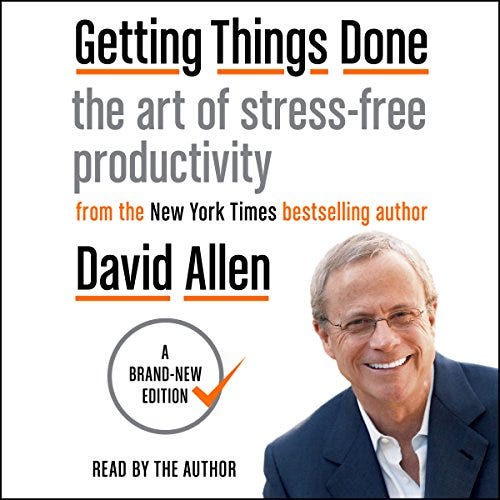Taking tasks from tangled to THRIVING: My fresh approach to Getting Things Done
With tasks coming in from all directions, and ALL OF THE TIME, I needed to find a way to switch from pure survival mode to deliberate strategic thinking. Prepare to enter my brain.
Where to begin?
That’s a question that sums up being overwhelmed with the sheer amount of STUFF TO DO that comes my way. It’s insidious. It creeps up over time.

My sources of woe include:
E-mail (Both work and personal). No inbox has quite reached the ‘ARRRRRRGH’ stage, but both inboxes have been acting as some sort of ‘You need to do this’ graveyard.
Talking to myself on WhatsApp when things pop into my head that I need to remember.
Phone notifications (Ping!)
Work Slack (Dozens of channels, Direct Messages, various ‘Saved for later’ bookmarks — oh, and the dubious privilege of being a Guest in a host of other Slack instances to keep track of).
Family Trello board (This has become a monstrous beast over time, moving away from the elegant nature of Kanban to a multi-headed hydra of DOOM: Blood-red ‘OVERDUE’ indicators staring with malice).
Work tasks embedded within my primary note-taking app, Obsidian.
People having the audacity to TALK TO ME.
It was getting too much. It was starting to feel like Tasks were getting in the way of actually Getting Things Done.
Getting Things Done
Getting Things Done is a personal productivity system developed by David Allen. Allen states "there is an inverse relationship between things on your mind and those things getting done". Aha! This was sounding familiar.
From Wikipedia:
The GTD method rests on the idea of moving all items of interest, relevant information, issues, tasks and projects out of one's mind by recording them externally and then breaking them into actionable work items with known time limits. This allows one's attention to focus on taking action on each task listed in an external record, instead of recalling them intuitively
Want to buy the book? Why, here’s a link so you can follow the same path.
Let’s get to work.
Step 0: Turning down the firehose
In this system, ‘All items of interest’ need to be sorted out. That leaves behind all items which are DEFINITELY NOT of interest. They may be distracting, annoying, spammy — perhaps all of these.
Sometimes, app developers just hate their users: I recently wanted to scan a bottle of wine in Vivino to find out more about it. I hadn’t used the app for ages. This time around, it forced me to sign up as a user. The app then proceeded to spam me daily with adverts about wine, and emails also started popping into my Inbox doing the same. A horrible user experience, all for ONE (JUST ONE!) bottle of wine.
I disabled the notifications and unsubscribed. I started doing for every single notification or email that wasn’t bringing actual value to my life. No, eBay, I don’t need to know about your current listing special offer. No, random shop I visited to buy a present for someone two years ago, I really don’t want to buy anything else from you. No, social_media_app_47, I just don’t care that ‘someone I might know’ posted something about teapots today.
Now, if I get an email or ‘ping’ on my mobile, the odds have moved a bit more in my favour that it is something I might actually care about.
Step 1: The Universal Inbox
At this point, I still had multiple places where Things That Need Doing could live. It was time to consolidate. And in the process hit the mythical INBOX ZERO.
I was always close to Inbox Zero. However, there would always be, Columbo style, ‘just one more thing’ that would be sat there as a reminder. Alongside this, I would be marking requests for help on Slack with a ‘Save for later’ — all a very vague way of tracking what needed to be done.
I use Obsidian as my primary work note taking application. It’s Markdown based, which I love, and it has a whole host of plugins to customise the experience. One of these plugins allows it to be used as a task tracking system (You can embed tasks within any note). It’s incredibly powerful but also takes some manual configuration to get it right for the individual. Ultimately, it wasn’t quite working for me with the general jumble of information. The tasks needed to go somewhere else.
But where?
The good news is that there is a whole host of Getting Things Done-inspired apps out there. I tried out a couple of the most popular for Mac: OmniFocus 4 and Things 3. Both of these are highly capable, well established and well thought of by their users. In the end, I settled for Things 3 as, well, it just passed the vibe check for me. It works well, it looks elegant and it just lets me get on with things. I also needed to make a decision quickly to avoid falling into a Paradox of Choice trap. Ultimately, these apps (and others) are so similar that I strongly suspect I’ll be writing an, “And now I have switched to Product X!” post in the future.
With that choice made, I threw everything that would stick into the my Things Inbox: Emails needing attention at some point, tasks from Obsidian, those flagged messages on Slack — everything just came pouring out of my mind. It was very cathartic. It gave me a Single Source Of Truth, and allowed me to clear down all the other places to nothing.
Hurrah! INBOX ZERO ACHIEVED.
Well, kind of. I now had a single massive Inbox. It was time to curate.
Step 2: Keeping my Things in order
Now that I had everything out of my mind and into a filing system, I needed a mechanism to complete the loop on it all.
This meant categorising everything into Areas and Projects (The screenshot above gives some examples of this: An area of ‘Family’ containing a Project of ‘Vacation in Rome’). Next up was setting realistic deadlines and the thing that actually needs to be done for each task.
To pick one of a myriad of home tasks, one was getting new football socks for my son. It got thrown into the Inbox, then filed into an appropriate ‘Home’ project with a date to be actioned some point over the weekend. This meant that Things handily popped it up to remind me. I ordered the socks, and created a new task for when they should be arriving so that I didn’t just forget about the whole thing (And means I don’t rely on loads of order status emails cluttering up my mail Inbox). Job done.
Although a trivial example, it highlights how a Task can be something you are waiting for someone else to do. This is a really useful approach to keeping more complex tasks under control.
Another handy helper here is that tasks can be recurring. Is there an outstandingly exciting Excel spreadsheet that you need to review once a week? You can make so very sure that the task in question will correctly come back to haunt you as required. Until you die, if necessary.
During all of this time, anything new appearing that needed my attention (such as email or Slack message) would go straight into my Things Inbox. All these competing Inboxes would start sprouting up again like weeds otherwise.
Step 3: Time management!

Task management is one thing. Time management is a challenge in its own right.
I’ve generally been good on discipline in this area, so this wasn’t something I needed to adjust too much. I allocate time in advance that matches when tasks need it. For example: If I need to write a hefty document for work, I’ll block out that writing time on the right days. If there are a complex series of inter-related tasks (a good recent example would be recruiting someone!) I’ll make sure that time is ring-fenced.
If it’s particularly Heavy Thinking Work [TM] I’ll drop into Pomodoro Time: Set a timer to work solely on that, turn off notifications and go into ‘Focus’ mode with whatever app I am using. I can then create happily within my little bubble.
I also put in time just for reviewing where I am with everything, to ensure a continued strategic view. Do I have the right things on my lists? Maybe priorities have changed. Are there things that I am NOT doing that I should be? Taking the time to step back and look at everything holistically is important.
Step 4: Is this actually working?
I’m not at this step yet. It’s early days and, as per the whole Get Things Done system, I need to review THE WHOLE THING at some point. We are at least at the, “Write a post about it” stage, so that’s something.
And, hey, writing this was a task in itself! So I can tick it off and move onto the next.
This is the sort of therapy that I can really get behind.
Please let me know how YOU are keeping yourself organised… or perhaps you aren’t?! What are your personal tips and challenges?




